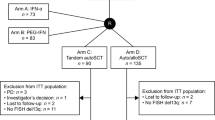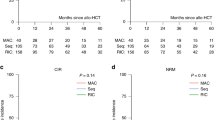Abstract
The aim of this retrospective analysis was to assess the benefit of reduced-intensity conditioning allo SCT (RIC allo-SCT) in a cohort of 32 relapsed multiple myeloma (MM) patients. A total of 19 patients had an HLA-identical sibling donor (‘donor’ group), while 13 patients had no donor (‘no-donor’ group). There were no significant differences between these two groups as for prognosis risk factors. Eighteen patients from the ‘donor’ group could actually proceed to RIC allo-SCT. With a median follow-up of 36 (range, 21–60) months, six patients died from transplant-related toxicity (cumulative incidence, 33% (95% CI, 11–55%)). Only 4 patients from the 18 transplanted patients (22%; 95% CI, 7–48%) progressed after RIC allo-SCT, as compared to 12 (86%; 95% CI, 56–98%; P=0.0003) among the nontransplanted patients. In an ‘intention-to-treat’ analysis, the Kaplan–Meier estimate of PFS was significantly higher in the ‘donor’ group as compared to the ‘no-donor’ group (P=0.01; 46 versus 8% at 3 years). There was no difference in terms of overall survival. However, in multivariate analysis, actual performance of RIC allo-SCT was associated with better PFS (relative risk, 0.35; 95% CI, 0.15–0.82; P=0.01). These data suggest a potential benefit for RIC allo-SCT in the management of relapsed MM warranting further prospective investigations.
This is a preview of subscription content, access via your institution
Access options
Subscribe to this journal
Receive 12 print issues and online access
$259.00 per year
only $21.58 per issue
Buy this article
- Purchase on Springer Link
- Instant access to full article PDF
Prices may be subject to local taxes which are calculated during checkout

Similar content being viewed by others
References
Hahn T, Wingard JR, Anderson KC, Bensinger WI, Berenson JR, Brozeit G et al. The role of cytotoxic therapy with hematopoietic stem cell transplantation in the therapy of multiple myeloma: an evidence-based review. Biol Blood Marrow Transplant 2003; 9: 4–37.
Attal M, Harousseau JL, Stoppa AM, Sotto JJ, Fuzibet JG, Rossi JF et al. A prospective, randomized trial of autologous bone marrow transplantation and chemotherapy in multiple myeloma. Intergroupe Francais du Myelome. N Engl J Med 1996; 335: 91–97.
Attal M, Harousseau JL, Facon T, Guilhot F, Doyen C, Fuzibet JG et al. Single versus double autologous stem-cell transplantation for multiple myeloma. N Engl J Med 2003; 349: 2495–2502.
Child JA, Morgan GJ, Davies FE, Owen RG, Bell SE, Hawkins K et al. High-dose chemotherapy with hematopoietic stem-cell rescue for multiple myeloma. N Engl J Med 2003; 348: 1875–1883.
Tricot G, Vesole DH, Jagannath S, Hilton J, Munshi N, Barlogie B . Graft-versus-myeloma effect: proof of principle. Blood 1996; 87: 1196–1198.
Mehta J, Singhal S . Graft-versus-myeloma. Bone Marrow Transplant 1998; 22: 835–843.
Lokhorst HM, Schattenberg A, Cornelissen JJ, van Oers MH, Fibbe W, Russell I et al. Donor lymphocyte infusions for relapsed multiple myeloma after allogeneic stem-cell transplantation: predictive factors for response and long-term outcome. J Clin Oncol 2000; 18: 3031–3037.
Lokhorst HM, Segeren CM, Verdonck LF, van der Holt B, Raymakers R, van Oers MH et al. Partially T-cell-depleted allogeneic stem-cell transplantation for first-line treatment of multiple myeloma: a prospective evaluation of patients treated in the phase III study HOVON 24 MM. J Clin Oncol 2003; 21: 1728–1733.
Kroger N, Schwerdtfeger R, Kiehl M, Sayer HG, Renges H, Zabelina T et al. Autologous stem cell transplantation followed by a dose-reduced allograft induces high complete remission rate in multiple myeloma. Blood 2002; 100: 755–760.
Kroger N, Sayer HG, Schwerdtfeger R, Kiehl M, Nagler A, Renges H et al. Unrelated stem cell transplantation in multiple myeloma after a reduced-intensity conditioning with pretransplantation antithymocyte globulin is highly effective with low transplantation-related mortality. Blood 2002; 100: 3919–3924.
Maloney DG, Molina AJ, Sahebi F, Stockerl-Goldstein KE, Sandmaier BM, Bensinger W et al. Allografting with nonmyeloablative conditioning following cytoreductive autografts for the treatment of patients with multiple myeloma. Blood 2003; 102: 3447–3454.
Mohty M, Boiron JM, Damaj G, Michallet AS, Bay JO, Faucher C et al. Graft-versus-myeloma effect following antithymocyte globulin-based reduced intensity conditioning allogeneic stem cell transplantation. Bone Marrow Transplant 2004; 34: 77–84.
Crawley C, Lalancette M, Szydlo R, Gilleece M, Peggs K, Mackinnon S et al. Outcomes for reduced-intensity allogeneic transplantation for multiple myeloma: an analysis of prognostic factors from the chronic leukaemia working party of the EBMT. Blood 2005; 105: 4532–4539.
Crawley C, Iacobelli S, Björkstrand B, Apperley JF, Niederwieser D, Gahrton G et al. Reduced intensity conditioning for myeloma: lower non-relapse mortality but higher relapse rates compared to myeloablative conditioning. Blood 2007; 109: 3588–3594.
Bensinger WI . The current status of reduced-intensity allogeneic hematopoietic stem cell transplantation for multiple myeloma. Leukemia 2006; 20: 1683–1689.
Kroger N, Schilling G, Einsele H, Liebisch P, Shimoni A, Nagler A et al. Deletion of chromosome band 13q14 as detected by fluorescence in situ hybridization is a prognostic factor in patients with multiple myeloma who are receiving allogeneic dose-reduced stem cell transplantation. Blood 2004; 103: 4056–4061.
Garban F, Attal M, Michallet M, Hulin C, Bourhis JH, Yakoub-Agha I et al. Prospective comparison of autologous stem cell transplantation followed by dose-reduced allograft (IFM99-03 trial) with tandem autologous stem cell transplantation (IFM99-04 trial) in high-risk de novo multiple myeloma. Blood 2006; 107: 3474–3480.
Bruno B, Rotta M, Patriarca F, Mordini N, Allione B, Carnevale-Schianca F et al. A comparison of allografting with autografting for newly diagnosed myeloma. N Engl J Med 2007; 356: 1110–1120.
Mohty M, Bay JO, Faucher C, Choufi B, Bilger K, Tournilhac O et al. Graft-versus-host disease following allogeneic transplantation from HLA-identical sibling with antithymocyte globulin-based reduced-intensity preparative regimen. Blood 2003; 102: 470–476.
Blade J, Samson D, Reece D, Apperley J, Bjorkstrand B, Gahrton G et al. Criteria for evaluating disease response and progression in patients with multiple myeloma treated by high-dose therapy and haemopoietic stem cell transplantation. Myeloma Subcommittee of the EBMT. European Group for Blood and Marrow Transplant. Br J Haematol 1998; 102: 1115–1123.
Gooley TA, Leisenring W, Crowley J, Storer BE . Estimation of failure probabilities in the presence of competing risks: new representations of old estimators. Stat Med 1999; 18: 695–706.
Kaplan EL, Meier P . Nonparametric estimation from incomplete observations. J Am Stat Assoc 1958; 53: 457–481.
Greipp PR, San Miguel J, Durie BG, Crowley JJ, Barlogie B, Blade J et al. International staging system for multiple myeloma. J Clin Oncol 2005; 23: 3412–3420.
Sorror ML, Maris MB, Storb R, Baron F, Sandmaier BM, Maloney DG et al. Hematopoietic cell transplantation (HCT)-specific comorbidity index: a new tool for risk assessment before allogeneic HCT. Blood 2005; 106: 2912–2919.
Singhal S, Mehta J, Desikan R, Ayers D, Roberson P, Eddlemon P et al. Antitumor activity of thalidomide in refractory multiple myeloma. N Engl J Med 1999; 341: 1565–1571.
Richardson PG, Barlogie B, Berenson J, Singhal S, Jagannath S, Irwin D et al. A phase 2 study of bortezomib in relapsed, refractory myeloma. N Engl J Med 2003; 348: 2609–2617.
Richardson PG, Blood E, Mitsiades CS, Jagannath S, Zeldenrust SR, Alsina M et al. A randomized phase 2 study of lenalidomide therapy for patients with relapsed or relapsed and refractory multiple myeloma. Blood 2006; 108: 3458–3464.
Aschan J, Lonnqvist B, Ringden O, Kumlien G, Gahrton G . Graft-versus-myeloma effect. Lancet 1996; 348: 346.
Verdonck LF, Lokhorst HM, Dekker AW, Nieuwenhuis HK, Petersen EJ . Graft-versus-myeloma effect in two cases. Lancet 1996; 347: 800–801.
Bertz H, Burger JA, Kunzmann R, Mertelsmann R, Finke J . Adoptive immunotherapy for relapsed multiple myeloma after allogeneic bone marrow transplantation (BMT): evidence for a graft-versus-myeloma effect. Leukemia 1997; 11: 281–283.
Gahrton G, Tura S, Ljungman P, Belanger C, Brandt L, Cavo M et al. Allogeneic bone marrow transplantation in multiple myeloma. European Group for Bone Marrow Transplantation. N Engl J Med 1991; 325: 1267–1273.
Bensinger WI, Buckner CD, Anasetti C, Clift R, Storb R, Barnett T et al. Allogeneic marrow transplantation for multiple myeloma: an analysis of risk factors on outcome. Blood 1996; 88: 2787–2793.
Gray R, Wheatley K . How to avoid bias when comparing bone marrow transplantation with chemotherapy. Bone Marrow Transplant 1991; 7 (Suppl 3): 9–12.
Mohty M, Attal M, Marit G, Bulabois CE, Garban F, Gratecos N et al. Thalidomide salvage therapy following allogeneic stem cell transplantation for multiple myeloma: a retrospective study from the Intergroupe Francophone du Myelome (IFM) and the Societe Francaise de Greffe de Moelle et Therapie Cellulaire (SFGM-TC). Bone Marrow Transplant 2005; 35: 165–169.
Kroger N, Zabelina T, Ayuk F, Atanackovic D, Schieder H, Renges H et al. Bortezomib after dose-reduced allogeneic stem cell transplantation for multiple myeloma to enhance or maintain remission status. Exp Hematol 2006; 34: 770–775.
van de Donk NW, Kroger N, Hegenbart U, Corradini P, San Miguel JF, Goldschmidt H et al. Remarkable activity of novel agents bortezomib and thalidomide in patients not responding to donor lymphocyte infusions following nonmyeloablative allogeneic stem cell transplantation in multiple myeloma. Blood 2006; 107: 3415–3416.
Bruno B, Patriarca F, Sorasio R, Mattei D, Montefusco V, Peccatori J et al. Bortezomib with or without dexamethasone in relapsed multiple myeloma following allogeneic hematopoietic cell transplantation. Haematologica 2006; 91: 837–839.
Acknowledgements
We thank the nursing staff for providing excellent care for our patients, and the physicians of the Hematology Department at the Institut Paoli-Calmettes for their important study contributions and dedicated patient care. We also thank the ‘Association pour la Recherche sur le Cancer (ARC)’ (Pole ARECA; ITAC protocols), the ‘Ligue Nationale contre le Cancer’, the ‘Fondation de France’, the ‘Fondation contre la Leucémie’, the ‘Agence de Biomédecine’, the ‘Association Cent pour Sang la Vie’ and the ‘Association Laurette Fuguain’, for their generous and continuous support for our clinical and basic research work. Our group is supported by several grants from the French ministry of health as part of the ‘Programme Hospitalier de Recherche Clinique (PHRC)’. HDL was supported by a grant from the ‘Fondation de France’ (Paris, France).
Author information
Authors and Affiliations
Corresponding author
Rights and permissions
About this article
Cite this article
de Lavallade, H., El-Cheikh, J., Faucher, C. et al. Reduced-intensity conditioning allogeneic SCT as salvage treatment for relapsed multiple myeloma. Bone Marrow Transplant 41, 953–960 (2008). https://doi.org/10.1038/bmt.2008.22
Received:
Revised:
Accepted:
Published:
Issue Date:
DOI: https://doi.org/10.1038/bmt.2008.22
Keywords
This article is cited by
-
Long-term outcomes of allogeneic stem cell transplant in multiple myeloma
Blood Cancer Journal (2023)
-
Current Role of Allogeneic Stem Cell Transplantation in Multiple Myeloma
Oncology and Therapy (2022)
-
Allogeneic Stem Cell Transplantation in Patients with High-Risk Multiple Myeloma: Utopia or Continuous Challenge in Aiming for Cure?
Current Treatment Options in Oncology (2021)
-
Utilization of hematopoietic stem cell transplantation for the treatment of multiple myeloma: a Mayo Stratification of Myeloma and Risk-Adapted Therapy (mSMART) consensus statement
Bone Marrow Transplantation (2019)
-
Allogeneic stem-cell transplantation for multiple myeloma: a systematic review and meta-analysis from 2007 to 2017
Cancer Cell International (2018)



